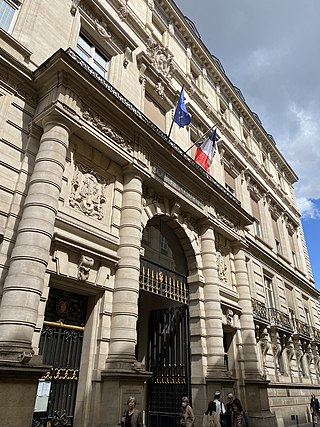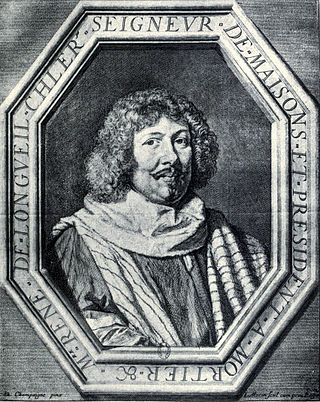Court in Paris
Early history
To oversee the Kingdom's revenues and expenditure, the French King first relied solely on his King's Court or Curia Regis, court officials who assisted him in governing. However, by the mid-12th century, the Crown entrusted its finances to the Knights Templar, who maintained a banking establishment in Paris. The royal Treasury was henceforth organized like a bank and salaries and revenues were transferred between accounts. Royal accounting officers in the field, who sent revenues to the Temple, were audited by the King's Court, which had special clerks assigned to work at the Temple. These financial specialists came to be called the Curia in Compotis and sat in special sessions of the King's Court for dealing with financial business. From 1297, accounts were audited twice yearly after Midsummer Day (June 24) and Christmas. In time, what was once a simple Exchequer of Receipts developed into a central auditing agency, branched off, and eventually specialized into a full-time court.
In 1256, Saint Louis issued a decree ordering all mayors, burgesses, and town councilmen to appear before the King's sovereign auditors of the Exchequer (French gens des comptes) in Paris to render their final accounting. The King's Court's general secretariat had members who specialized in finance and accountancy and could receive accounts. A number of Barons (maîtres lais) were commissioned to sit as the King's Exchequer (comptes du Roi).
In or around 1303, the Paris Court of Accounts was established in the Palais de la Cité where it remained until the French Revolution. Its auditors were responsible for overseeing revenue from Crown estates and checking public spending. It audited the Royal Household, inspectors, royal commissioners, provosts, and lower court justices. In 1307, the Philip IV definitively removed royal funds from the Temple and placed them in the fortress of the Louvre. Thereafter, the financial specialists received accounts for audit in a room of the royal palace that became known as the Camera compotorum or Chambre des comptes, and they began to be collectively identified under the same name, although still only a subcommittee within the King's Court, consisting of about sixteen people.
The Vivier-en-Brie Ordinance of 1320, issued by Philip V, required the Chambre to audit finances, judge cases arising from accountancy, and maintain registers of financial documents; it also laid out the basic composition of financial courts: three (later four) cleric masters of accounts (maîtres-clercs) to act as chief auditors and three lay Barons (maîtres-lais familiers du Roi) empowered to hear and adjudge ("oyer and terminer") audit accounts. They were assisted by eleven clerks (petis clercs, later clercs des comptes) who acted as auditors of the prests. This complement grew by 50% in the next two decades but was reduced to seven masters and twelve clerks in 1346. The office of churchman Chief Baron (président) was created by the Ordinance of 1381, and a second lay Chief Baron was appointed in 1400. Clerks of court were eventually added to the Court's composition. Examiners (correcteurs) were created to assist the Barons (maitres). Other court officers (conseillers) appointed by the King were created to act alongside the puisne Barons (maîtres ordinaires). Lastly, the Ordinance of 26 February 1464 named the Court of Accounts as the "sovereign, primary, supreme, and sole court of last resort in all things financial". [1]
While gaining in stability in the later 14th century, the Court lost its central role in royal finances. First, currency was moved to a separate body (Chambre des monnaies), then the increasingly regular "extraordinary" taxes (aide, tallage, gabelle) became the responsibility of the généraux of the Cour des aides (created in 1390). The Crown's domainal revenues, still retained by the Court of Accounts, fell in importance and value. By 1400, the Court's role had been much reduced. However, with the gradual enlargement of the Realm through conquest, the need for the Court remained secure.

The Cour des Comptes is France's supreme audit institution, under French law an administrative court. As such, it is independent from the legislative and executive branches of the French Government. However, the 1946 and 1958 French constitutions made it the Court's duty to assist the Cabinet and Parliament in regulating government spending. The Court thus combines functions of a court of exchequer, comptroller general's office, and auditor general's office in common-law countries. It is also a Grand Corps of the French State and mainly recruits among the best-ranked students graduating from the Ecole nationale d'administration.
The Controller-General or Comptroller-General of Finances was the name of the minister in charge of finances in France from 1661 to 1791. It replaced the former position of Superintendent of Finances, which was abolished with the downfall of Nicolas Fouquet. It did not hold any real political power until 1665, when First Minister Jean-Baptiste Colbert, who had acted upon financial matters since Fouquet's embezzlement charge, was appointed to the office.

The Superintendent of Finances was the name of the minister in charge of finances in France from 1561 to 1661. The position was abolished in 1661 with the downfall of Nicolas Fouquet, and a new position was created, the Controller-General of Finances.

René de Longueil, marquis (1658) de Maisons (1596–1677), le président de Maisons, was Surintendant des Finances under Louis XIV. He built the Château de Maisons.

Thomas-François de Treil de Pardailhan was the eldest of an ennobled Languedocien family, originating in the Saint-Pons-de-Thomières region. At first an officer in the Maison Militaire du Roi, baron Thomas de Treil de Pardailhan was Maître d'hôtel du Roi at the Court of Versailles at the end of the Ancien Régime. His writings, however, show him as an opponent of the privileges of aristocracy and in favor of the new ideas. The French Revolution marks a rupture with his milieu: in support of deep social reform, he was elected député for Paris in 1791 to the Legislative Assembly, but always remained attached to the idea of a constitutional monarchy and was imprisoned as a suspect during the Reign of Terror. Ruined by bad business dealings under the Directory and by sources of income he had lost in the Revolution, he ended his life at his château at Pardailhan in 1822.
Antoine Boësset, Antoine Boesset or Anthoine de Boesset, sieur de Villedieu, was the superintendent of music at the Ancien Régime French court and a composer of secular music, particularly airs de cour. He and his father-in-law Pierre Guédron dominated the court's musical life for the first half of the 17th century under Louis XIII. His son Jean-Baptiste [de] Boesset, sieur de Dehault, composed church music.
Jean-Roland Malet or Mallet was a French economic historian, author of the Comptes rendus de l'administration des finances du royaume, which constitute the most important source of economic and financial data for Ancien Régime France.
Georges Jean Gabriel Vianès is a former French civil servant, corporate officer and politician. He was head of the French National Industrial Property Institute, the French national intellectual property office from 1975 to 1982. He was also the first Chairman of the Administrative Council of the European Patent Organisation, from 19 October 1977 to 18 October 1981.
Nicolas-Félix Van Dievoet called Vandive, écuyer, (c.1710–1792) was a French court official

The International Organization of Supreme Audit Institutions (INTOSAI) is an intergovernmental organization whose members are supreme audit institutions. Nearly every supreme audit institution in the world is a member of INTOSAI. Depending on the type of system used in their home country, the members of INTOSAI may be variously titled the Chief Financial Controller, the Office of the Comptroller General, the Office of the Auditor General, the Court of Accounts, or the Board of Audit.
Nicolas-François Dupré de Saint-Maur was a French economist and statistician.
A supreme audit institution is an independent national-level institution which conducts audits of government activities. Most supreme audit institutions are established in their country's constitution, and their mandate is further refined in national legislation. Supreme audit institutions play an important role in providing oversight and accountability in a country by monitoring the use of public funds and reviewing the quality and accuracy of government financial reporting. They also contribute to anti-corruption efforts. Depending on the country, a supreme audit institution may be called a court of audit, auditor-general or the board of audit. Nearly every supreme audit institution in the world is a member of the International Organization of Supreme Audit Institutions, which works to establish and disseminate international standards and good practices.
Jean de Laforcade, Seigneur de La Fitte-Juson, aka Jean de Laforcade, Seigneur de La Fitte-Suzon (sic), aka Jean de La Forcade, aka Jean de La Fourcade, aka Jean de la Fourcade, aka Jean de Lafourcade, aka Jean de Laforcade, aka Jean de Fourcade, was the son of Protestant nobleman Jean de Laforcade, Seigneur de La Fitte, and a descendant of the noble family of Forcade of Béarn in Navarre.
Jean de Laforcade, Seigneur de La Fitte, aka Jean Laforcade, Seigneur de Lafitte, aka Jean Lafourcade, aka Jean II. de Forcade, was a Protestant nobleman and a descendant of the noble family of Forcade of Béarn in Navarre.
The Chambres des Comptes de Navarre, alias Cour des Comptes de Navarre(English: Court of Auditors of Navarre), was formed in April 1624 during the reign of Louis XIII through the act of merging the Chambre des Comptes of Pau with the Chambre des Comptes of Nérac into one entity. In 1691, it was merged into the Parliament of Navarre and Béarn in Pau. The First President and the two Presidents, became Président à mortiers in the Parliament.
The Sovereign Council of Navarre and Béarn was created by Henry II of Navarre at the Château de Pau on 13 June 1519, replacing the Cour Majour which was disbanded in 1490.
When the Kingdom of Navarre was united with France by the marriage of Philip IV of France with Joan I Queen Regnant of Navarre and Countess of Champagne on 16 August 1284, it kept the long existing Chancery of Navarre(French: Chancellerie de Navarre). The Kings of Navarre had private Chancellors dating back to ancient kings. Theobald II of Navarre had a Vice-Chancellor, according to letters dated 1259.
The Parlement of Pau(French: "Parlement de Pau", alias "Parlement de Navarre et de Béarn", alias "Parlement de Navarre séant à Pau") was created in 1620 out of the merger of the Conseil Souverain of Béarn and the Chancery of Navarre, with its subordinated offices, by Louis XIII of France, following the incorporation of Béarn and Lower Navarre into the crown lands of France.
The Mint of Navarre and Béarn was formed through the merger of the Mint of Navarre in Saint-Palais, whose construction was originally authorized by Charles the Bad in 1351, and placed under the authority of the Chambre des Comptes of Navarre on 4 January 1527, with the two Mints of Béarn in Pau and Morlaàs, in Béarn, in 1562.

Louis Hesselin, Seigneur de Condé was a French aristocrat, government official, patron and collector. He held various positions in the royal household and became Intendant of the Menus Plaisirs around 1655.






